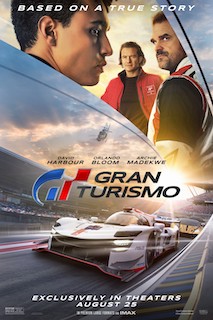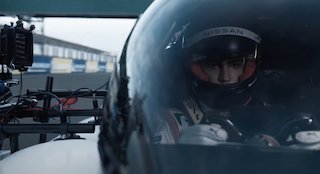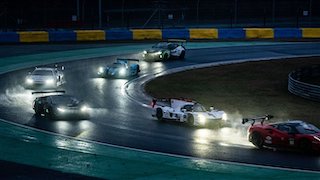 Gran Turismo: Based on a True Story, the new film from Sony Pictures and director Neill Blomkamp, is based on the unbelievable true story of a team of unlikely underdogs – a struggling working-class gamer (Archie Madekwe), a failed former racecar driver (David Harbour), and an idealistic motorsport executive (Orlando Bloom). Together, they risk it all to take on the most elite sport in the world. Gran Turismo is an inspiring, thrilling, and action-packed story that proves that nothing is impossible when you’re fueled from within. The film gave filmmakers the chance to capture the visceral sounds of cars.
Gran Turismo: Based on a True Story, the new film from Sony Pictures and director Neill Blomkamp, is based on the unbelievable true story of a team of unlikely underdogs – a struggling working-class gamer (Archie Madekwe), a failed former racecar driver (David Harbour), and an idealistic motorsport executive (Orlando Bloom). Together, they risk it all to take on the most elite sport in the world. Gran Turismo is an inspiring, thrilling, and action-packed story that proves that nothing is impossible when you’re fueled from within. The film gave filmmakers the chance to capture the visceral sounds of cars.
For the team’s post-production sound team, led by supervising sound editors Kami Asgar and Erin Oakley, and re-recording mixers Kevin O’Connell and Beau Borders, the film also fulfilled a deeply held wish, providing them with an unprecedented opportunity to recreate the sounds of some of the world’s fastest cars and one of its most popular games in a story that tugs at the heart and keeps audiences on the edges of their seats. “When I read that Neill was making a Gran Turismo film,” says Asgar, “I immediately thought, ‘We have to do this movie!’”
Asgar explains that he, Oakley, O’Connell, and Borders are all “motor heads” with deep connections to cars and a love for racing. “I used to manage off road race teams and participated in several Baja 1000s,” he relates. “Erin is super competitive. She rides a Harley and takes part in off-road sports. Beau is a professional racecar driver and Kevin is also an avid car and motorcycle lover.”
What immediately jumps out about the film’s sound is the authenticity of the cars and the many thrilling race sequences. Asgar says that, from the beginning of post sound, Blomkamp was intent on drawing the audience into the story by capturing the visceral nature of the sport with pinpoint realism.
 “Erin and I watched the movie with Neill and talked cars,” he recalls. “He was insistent that the cars sound authentic, nothing canned, everything pure whether it’s race cars or street cars. He felt the same way about the game. Wherever possible, we needed to inject actual sounds from the game into the movie.”
“Erin and I watched the movie with Neill and talked cars,” he recalls. “He was insistent that the cars sound authentic, nothing canned, everything pure whether it’s race cars or street cars. He felt the same way about the game. Wherever possible, we needed to inject actual sounds from the game into the movie.”
To help tell the story, the sound team needed genuine sounds of each car appearing on screen—engines starting, idling, and revving, gear shifts, exhaust and induction, cockpit noises, screeching tires and whining transmissions. To gather those very specific sounds, recordists traveled to airfields and racetracks in London and California to record cars identical to those in the film. Crews used dozens of specialized mics to get as close as possible to engine parts, wheels, and other exterior features and to record the vehicles from a dizzying range of perspectives.
It was a complicated and arduous task. “To record professional race cars, you need drivers, mechanics, fuel, and tires. You must schedule and coordinate a whole team,” explains Asgar. “Plus, cars like these aren’t ready at a moment’s notice. They are disassembled after each race, so they need reassembly.” Asgar adds that recording teams were also dispatched to Daytona, Sebring, and the LA Grand Prix to record pit crews, crowds, and other ambient sounds.
 Dialogue spoken by actors in cars traveling at high speed presented a different kind of challenge.
Dialogue spoken by actors in cars traveling at high speed presented a different kind of challenge.
“Getting clean dialogue tracks was critical,” says Oakley. “But it was difficult during racing scenes because actors were talking over engine noise. And, they were often speaking very fast, in unfamiliar accents and using racing lingo. We had to work hard both in editorial and in the mix to produce dialogue tracks that were clear and natural so that we didn’t lose a joke or miss a story point.”
To further the sense of realism, the team brought in real world racetrack announcers to commentate on races in the film as if they were real events. “We had English-, French- and German-speaking announcers, as well as some who spoke Arabic for a race in Dubai,” recalls Oakley. “It was so much fun! Normally, when we record talent in the studio, we do multiple takes, but these guys were professionals, they sounded authentic right off the bat. And, except where we needed specific dialogue, none of it was scripted. We’d give them general direction, and they’d put it in their own words. For further realism, we recorded them with Coles 4104 microphones, the same mics they use at the track.”
 A similarly challenging task involved conversations between drivers and their spotters (trackside crew who provide information and advice), that occur via racing headsets. “We hired a professional driver to write accurate dialogue for our loop group actors,” explains Oakley. “In the movie, this dialogue is used as squawking background chatter to give the audience the feel of being part of the race. It sounds spontaneous, but it was carefully thought out and time-consuming to get just right.”
A similarly challenging task involved conversations between drivers and their spotters (trackside crew who provide information and advice), that occur via racing headsets. “We hired a professional driver to write accurate dialogue for our loop group actors,” explains Oakley. “In the movie, this dialogue is used as squawking background chatter to give the audience the feel of being part of the race. It sounds spontaneous, but it was carefully thought out and time-consuming to get just right.”
For scenes where the characters are playing the Gran Turismo game, the sound team was provided with original sound elements from the actual game by PlayStation and the developer Polyphony Digital. “They were super helpful in getting us the details of the cars and driving action that we needed,” Asgar recalls. “A lot of it was hard to isolate because it was mixed with music and background ambience, but they were able to pare it down to the engines, tires and skids.”
Final mixing was performed at Sony Pictures in Culver City in its historic Cary Grant Theater. O’Connell and Borders removed extraneous sounds from the production tracks, sculpted the sound design, and weaved in music in a way that gives the action scenes a fiery intensity, while preserving their intimacy and nuance Oakley believes that audiences are going to be enthralled with Gran Turismo and its uplifting story about following one’s dreams. “It takes a great team to produce results like this,” she says. “I’m so proud of the work of the sound editors, mixers, and picture editors. Each of them gave it their all to serve the story and deliver a movie that sounds incredibly good.”
